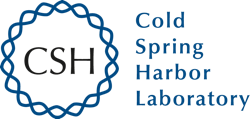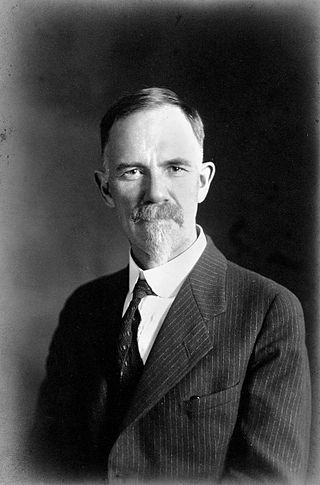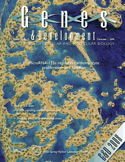
James Dewey Watson is an American molecular biologist, geneticist, and zoologist. In 1953, he co-authored with Francis Crick the academic paper proposing the double helix structure of the DNA molecule. Watson, Crick and Maurice Wilkins were awarded the 1962 Nobel Prize in Physiology or Medicine "for their discoveries concerning the molecular structure of nucleic acids and its significance for information transfer in living material". In subsequent years, it has been recognized that Watson and his colleagues did not properly attribute colleague Rosalind Franklin for her contributions to the discovery of the double helix structure.

Cold Spring Harbor Laboratory (CSHL) is a private, non-profit institution with research programs focusing on cancer, neuroscience, plant biology, genomics, and quantitative biology.
CSH is a three-letter acronym with multiple meanings:
The Eugenics Record Office (ERO), located in Cold Spring Harbor, New York, United States, was a research institute that gathered biological and social information about the American population, serving as a center for eugenics and human heredity research from 1910 to 1939. It was established by the Carnegie Institution of Washington's Station for Experimental Evolution, and subsequently administered by its Department of Genetics.

Charles Benedict Davenport was a biologist and eugenicist influential in the American eugenics movement.
Joseph Frank Sambrook was a British molecular biologist known for his studies of DNA oncoviruses and the molecular biology of normal and cancerous cells.
Tom Maniatis, is an American professor of molecular and cellular biology. He is a professor at Columbia University, and serves as the Scientific Director and CEO of the New York Genome Center.

Lysogeny broth (LB) is a nutritionally rich medium primarily used for the growth of bacteria. Its creator, Giuseppe Bertani, intended LB to stand for lysogeny broth, but LB has also come to colloquially mean Luria broth, Lennox broth, life broth or Luria–Bertani medium. The formula of the LB medium was published in 1951 in the first paper of Bertani on lysogeny. In this article he described the modified single-burst experiment and the isolation of the phages P1, P2, and P3. He had developed the LB medium to optimize Shigella growth and plaque formation.

Genome Research is a peer-reviewed scientific journal published by Cold Spring Harbor Laboratory Press. Disregarding review journals, Genome Research ranks 2nd in the category 'Genetics and Genomics' after Nature Genetics. The focus of the journal is on research that provides novel insights into the genome biology of all organisms, including advances in genomic medicine. This scope includes genome structure and function, comparative genomics, molecular evolution, genome-scale quantitative and population genetics, proteomics, epigenomics, and systems biology. The journal also features interesting gene discoveries and reports of cutting-edge computational biology and high-throughput biology methodologies. New data in these areas are published as research papers, or methods and resource reports that provide novel information on technologies or tools that will be of interest to a broad readership. The journal was established in 1991 as PCR Methods and Applications and obtained its current title in 1995. According to the Journal Citation Reports, the journal has a 2020 impact factor of 9.043, which peaked in 2014 at 14.630.
TAE buffer is a buffer solution containing a mixture of Tris base, acetic acid and EDTA.
Bacteriophage (phage) are viruses of bacteria and arguably are the most numerous "organisms" on Earth. The history of phage study is captured, in part, in the books published on the topic. This is a list of over 100 monographs on or related to phages.
Cold Spring Harbor Laboratory Press was founded in 1933 to aid in Cold Spring Harbor Laboratory's purpose of furthering the advance and spread of scientific knowledge.
Springer Protocols was a database of life sciences protocols published by Springer Science+Business Media. It replaced BioMed Protocols, a Humana Press database, in January 2008, and was deactivated on 25 July 2018. The protocols were then available on the SpringerLink website.

Genes & Development is a peer-reviewed scientific journal covering molecular biology, molecular genetics, cell biology, and development. It was established in 1987 and is published twice monthly by Cold Spring Harbor Laboratory Press in association with The Genetics Society.
Immunosurgery is a method of selectively removing the external cell layer (trophoblast) of a blastocyst through a cytotoxicity procedure. The protocol for immunosurgery includes preincubation with an antiserum, rinsing it with embryonic stem cell derivation media to remove the antibodies, exposing it to complement, and then removing the lysed trophoectoderm through a pipette. This technique is used to isolate the inner cell mass of the blastocyst. The trophoectoderm's cell junctions and tight epithelium "shield" the ICM from antibody binding by effectively making the cell impermeable to macromolecules.

Transgenic Research, international in scope, is a bimonthly, peer-reviewed, scientific journal, published by Springer. The co-editors-in-chief are Johannes Buyel and Simon Lillico.

David L. Spector is a cell and molecular biologist best recognized for his research on gene expression and nuclear dynamics. He is currently a professor at Cold Spring Harbor Laboratory (CSHL). Since 2007, he has served as Director of Research of CSHL.
The International Society for Extracellular Vesicles (ISEV) is an international scientific organization that focuses on the study of extracellular vesicles (EV), including exosomes, microvesicles, oncosomes, and other membrane-bound particles that are released from cells. Established in 2011, the society is a nonprofit organization. It is governed by an executive committee. The current president is Buzás Edit. Previous presidents were Clotilde Théry (2018-2022), Andrew Hill (2016-2018) and founding president Jan Lötvall (2011-2016). The society publishes the Journal of Extracellular Vesicles and the Journal of Extracellular Biology.
John Tooze FRS was a British research scientist, research administrator, author, science journalist, former executive director of EMBO/EMBC, director of research services at the Cancer Research UK London Research Institute and a vice president at The Rockefeller University.
Ramamirtha Jayaraman was an Indian geneticist, known for his studies on bacteria, especially on Escherichia coli. His researches on the control of transcription of bacteria are known to have evidenced the participation of accessory factors in transcription and their interactions with RNA polymerase. He was a professor at the Madurai Kamaraj University (MKU) and a former scientist at Tata Institute of Fundamental Research. Post his retirement, he served as an emeritus scientist at MKU. He authored the reference manual, Jayaraman Laboratory Manual in Molecular Genetics and several pamphlets and articles; PubMed, an online repository of medical papers has listed 59 of them. The Council of Scientific and Industrial Research, the apex agency of the Government of India for scientific research, awarded him the Shanti Swarup Bhatnagar Prize for Science and Technology, one of the highest Indian science awards, in 1982, for his contributions to biological sciences.








